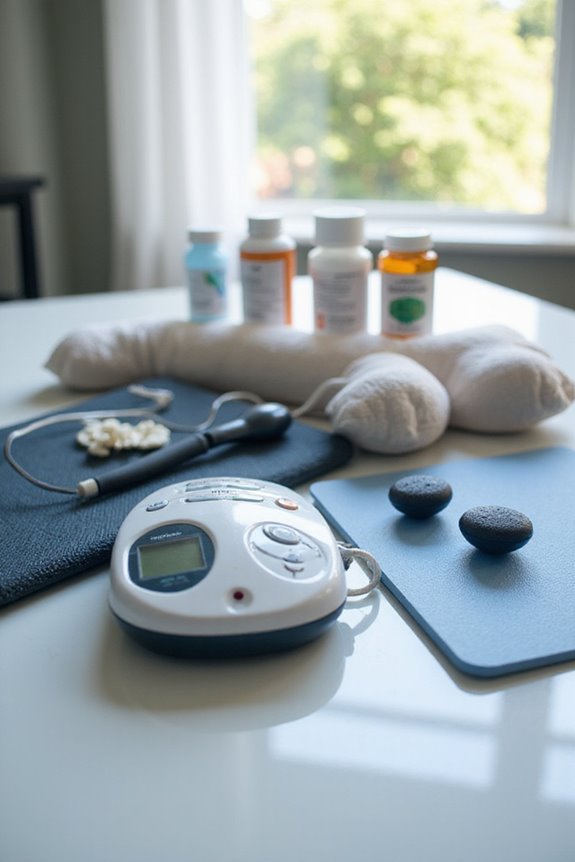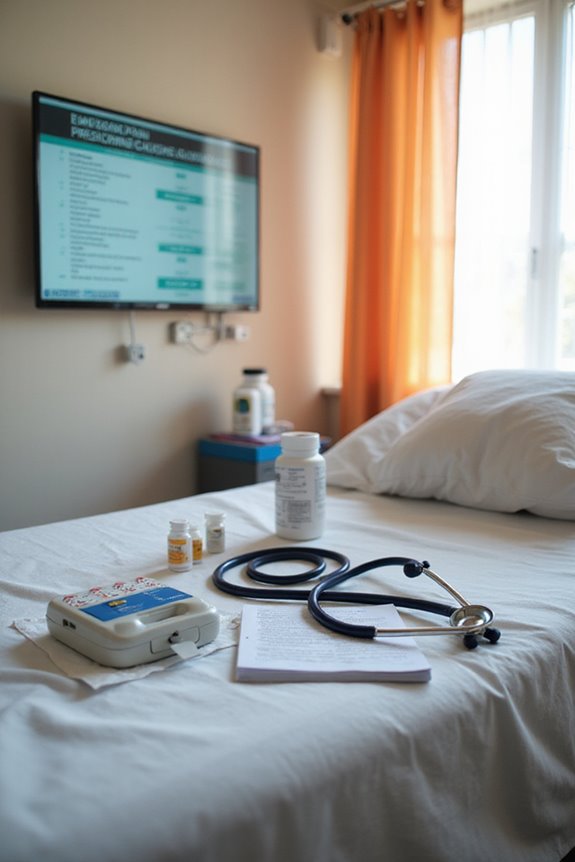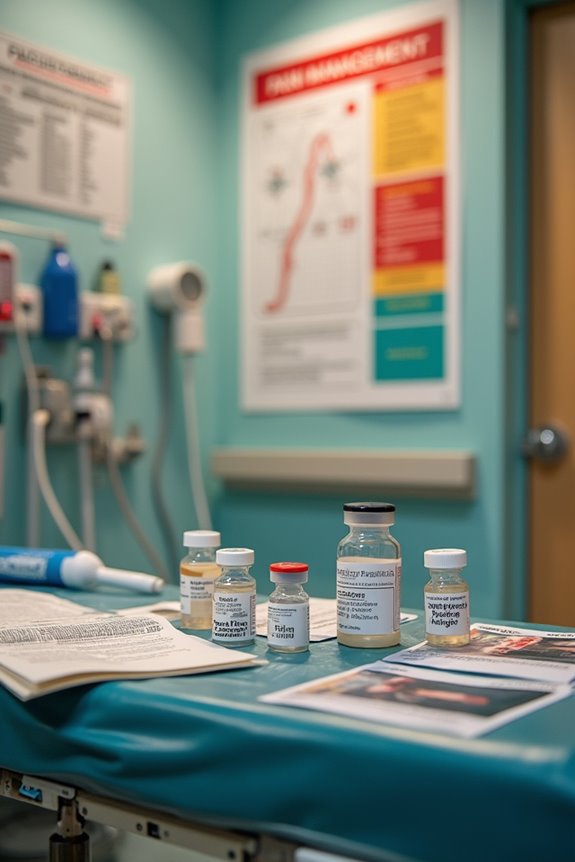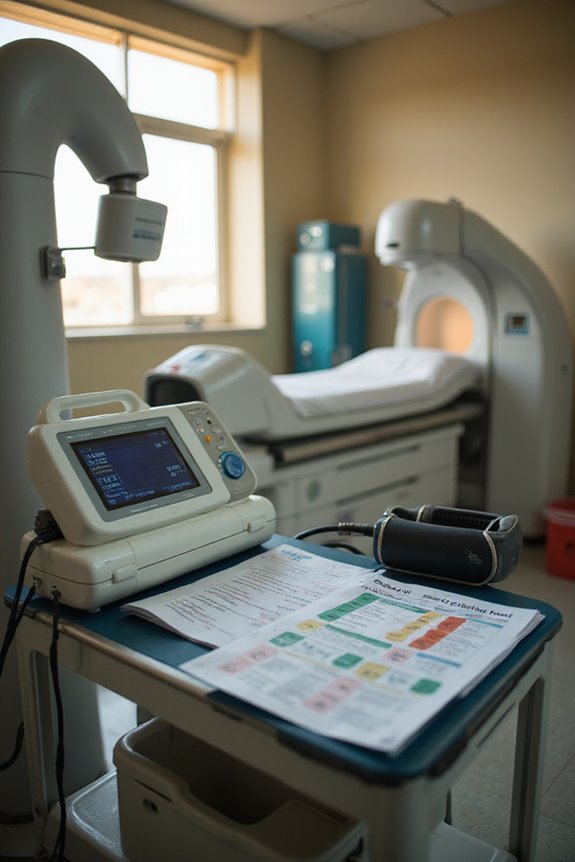To advocate for pain treatment in emergency settings, one must utilize effective pain assessment tools, such as the Numerical Rating Scale (NRS) and Visual Analog Scale (VAS). Individualized pain management and multimodal analgesia enhance treatment efficacy. Following opioid prescribing guidelines guarantees responsible management. Implementing standardized pain protocols and collaborating with multidisciplinary teams is essential. Patient education on non-opioid alternatives and monitoring for aberrant drug-related behaviors further supports effective pain management. Additional insights are available on best practices and strategies.
Key Takeaways
- Clearly communicate your pain level using validated assessment tools like the Numerical Rating Scale (NRS) or Visual Analog Scale (VAS) to ensure accurate evaluation.
- Express your individual pain management preferences and concerns to your healthcare team to facilitate shared decision-making in your treatment plan.
- Request multimodal analgesia options that incorporate both pharmacologic and non-pharmacologic interventions for comprehensive pain relief.
- Stay informed about the risks and benefits of prescribed pain medications to actively engage in discussions and advocate for safe treatment options.
- If you encounter any aberrant drug-related behaviors, report them to your healthcare provider to ensure your safety and appropriate pain management.
Understanding Pain Assessment Tools in Emergency Care
Pain assessment tools are critical components in emergency care, facilitating the effective evaluation of patient discomfort. Various pain assessment methods, including the Numerical Rating Scale (NRS) and Visual Analog Scale (VAS), serve to quantify pain intensity.
- NRS operates on an 11-point scale, while VAS uses a 10 cm line for marking pain levels.
- Pain scale comparison reveals that NRS closely correlates with VAS, enhancing their interchangeable use.
- Assessment challenges arise particularly in trauma cases, where patient distress may hinder effective use.
Additional tools like the Defense and Veterans Pain Rating Scale (DVPRS) and non-verbal scales are essential for patients unable to communicate. Standardizing these tools improves communication and treatment efficacy among emergency providers, addressing the gaps in timely pain management.
The Importance of Individualized Pain Management

Individualized pain management (IPM) is essential in enhancing treatment efficacy, particularly in emergency settings where patients present with diverse pain profiles.
- Evidence shows that individualized treatment plans can improve patient satisfaction and provider comfort when managing conditions like sickle cell disease.
- Implementing electronic health record-embedded individualized pain plans (E-IPPs) not only streamlines access but also supports adherence to tailored protocols.
- Multimodal analgesia, which aligns with individualized treatment, offers effective pain relief while minimizing adverse effects.
- Studies indicate that addressing patient preferences and unique pain patterns leads to enhanced treatment outcomes and reduced opioid-related complications.
Engaging Patients in Shared Decision-Making

Engaging patients in shared decision-making (SDM) is a critical component of effective pain management in emergency settings. This approach guarantees that patient preferences are central to discussions about treatment options, even in time-sensitive situations.
Key principles include:
- Clear communication of management options, using simple, jargon-free language.
- Active listening to understand the patient’s pain experience and concerns.
- Transparency regarding diagnostic uncertainties to build trust and reduce unnecessary interventions.
Utilizing SDM tools can enhance patient understanding and satisfaction, leading to better adherence to treatment plans. Additionally, incorporating patient values may result in reduced opioid prescriptions while improving overall patient outcomes. Ultimately, SDM fosters a collaborative environment, empowering patients to participate actively in their pain management decisions.
Utilizing Multimodal Analgesic Approaches

Multimodal analgesic approaches represent an all-encompassing strategy for managing pain in emergency settings, greatly enhancing patient outcomes. These strategies combine various medications, yielding multimodal benefits that include reduced opioid consumption and decreased risks of side effects such as respiratory depression and nausea.
Key components of multimodal analgesic strategies include:
- Non-opioid agents: NSAIDs and acetaminophen reduce inflammation through diverse pathways.
- Adjuncts: Alpha-2-agonists like clonidine and sub-dissociative ketamine enhance analgesia.
- Regional techniques: Regional anesthesia paired with systemic analgesics optimizes pain control.
Additionally, careful selection of administration routes—such as intravenous, intranasal, or nebulized methods—ensures patient comfort and safety. These extensive approaches facilitate better pain management and improved overall patient satisfaction in emergency care.
Navigating Opioid Prescribing Guidelines

Steering opioid prescribing guidelines is paramount for emergency departments aiming to provide effective pain management while minimizing the risks associated with opioid use. The CDC guidelines advocate for the lowest effective dosage and the shortest prescription duration limits, emphasizing opioid risk mitigation.
Key aspects of these guidelines include:
- Tailoring therapy based on patient assessment, particularly pain severity and comorbidities.
- Prioritizing nonopioid therapies and reserving opioids for moderate to severe pain.
- Continuous re-evaluation of pain and function during opioid therapy.
State-level guidelines reinforce these principles by restricting prescription quantities, discouraging intravenous or intramuscular opioids for chronic pain, and promoting care coordination to enhance management while reducing misuse risks. Compliance with these guidelines is essential for safe opioid prescribing in emergency settings.
Addressing Regulatory Constraints in Pain Treatment
How can regulatory constraints shape the landscape of pain treatment in emergency settings? Regulatory challenges greatly impact pain management, particularly through rigid opioid prescribing limits established post-CDC guidelines.
- States often impose restrictions leading to abrupt opioid discontinuation, risking withdrawal and harm.
- Diminished access affects not only chronic pain patients but also those requiring urgent care, such as cancer and surgery patients.
- High patient-to-nurse ratios in emergency departments hinder effective pain assessment.
- Legal and ethical barriers create ambiguity, discouraging adequate pain relief due to fear of repercussions.
Inadequate support and restrictive policies can exacerbate disparities in pain management, necessitating advocacy for improved regulatory frameworks that prioritize patient care and effective pain treatment.
Implementing Standardized Pain Management Protocols
Implementing standardized pain management protocols is essential for enhancing the quality of care in emergency settings. These protocols foster consistency and reduce treatment disparities. Key components include:
- Protocol Development: Incorporating stepwise algorithms that integrate pharmacologic and non-pharmacologic interventions tailored to patient needs, based on national and international guidelines.
- Interdisciplinary Collaboration: Successful implementation requires cooperation among emergency physicians, nurses, and paramedics to align protocols with their training and scope of practice.
- Pain Assessment: Regular use of validated pain assessment tools is vital for guiding treatment decisions and ensuring effective pain control.
Such structured frameworks not only optimize patient outcomes but also promote a unified approach to pain management, benefiting both healthcare providers and patients alike.
Collaborating With Multidisciplinary Teams
Collaborating with multidisciplinary teams is an essential component of effective pain management in healthcare settings. Team collaboration enhances the quality of care through diverse expertise, ensuring thorough assessment and treatment.
Key elements include:
- Inclusion of professionals for biological, psychological, and functional assessments.
- Regular interdisciplinary meetings to discuss complex cases.
- Coordination of care by designating a case coordinator for organized follow-ups.
- Clear role clarity among team members to prevent overlap and confusion.
- Utilization of shared electronic medical records for timely information access.
Educating Patients on Non-Opioid Alternatives
What options exist for patients seeking effective pain management without the use of opioids?
Non-opioid education is critical in emergency settings. Effective alternatives include:
- Non-opioid analgesics: NSAIDs, acetaminophen, ketamine, and antidepressants provide comparable relief with fewer risks.
- Physical therapies: Techniques such as physical therapy, acupuncture, and chiropractic care enhance function and pain control.
- Interventional procedures: Nerve blocks and injections target specific pain areas.
Patient engagement is essential; educating patients about treatment goals, expected pain trajectories, and the benefits versus risks of each option fosters shared decision-making.
Monitoring and Identifying Aberrant Drug-Related Behaviors
Monitoring and identifying aberrant drug-related behaviors is essential for effective pain management and patient safety. Various aberrant behaviors may include:
- Altering the route of administration, such as crushing tablets or injecting substances.
- Obtaining opioids from multiple sources, including doctor shopping or illicit dealers.
- Unsanctioned use, like unauthorized dose escalation or stockpiling medications.
- Drug-seeking behavior, characterized by requests for higher doses or lost prescriptions.
Effective monitoring strategies involve utilizing tools such as the SOAPP-14 and CAGE-AID, along with urine drug testing. Continuous observation of patient behavior, communication with prior providers, and documentation of any unusual requests enable healthcare professionals to identify and manage these behaviors promptly. Frequent reassessment of pain and functionality is vital to balance treatment effectiveness with the risk of misuse.
Frequently Asked Questions
What Role Does Patient Advocacy Play in Pain Management?
Patient advocacy in pain management fosters patient empowerment through effective communication, ensuring individuals understand their options. This support enhances trust, improves treatment adherence, and ultimately leads to better health outcomes and quality of life for patients.
How Can Family Members Support Pain Treatment Discussions?
In the intricate tapestry of pain treatment discussions, family members weave emotional support and communication strategies together, crafting a safe haven where understanding flourishes, enabling patients to navigate their pain journeys with confidence and connection.
What Are the Consequences of Untreated Pain in Emergency Settings?
Untreated pain in emergency care can lead to chronic pain development, prolonged hospital stays, and diminished quality of life. Patients may also experience increased healthcare costs and psychological distress, underscoring the urgent need for effective pain management.
How Can Cultural Differences Affect Pain Management Approaches?
In a world where cultural perceptions dictate pain, communication barriers flourish. Society awards gold stars for stoicism, leaving misunderstandings rampant. Therefore, pain remains unrecognized, while providers, oblivious, continue their dance around patients’ authentic experiences.
What Resources Are Available for Patients Seeking Pain Treatment?
Patients seeking pain treatment options can access valuable resources, including patient support groups that provide shared experiences and information, helping individuals navigate their pain management journeys and fostering a sense of community and belonging in their healthcare experiences.





